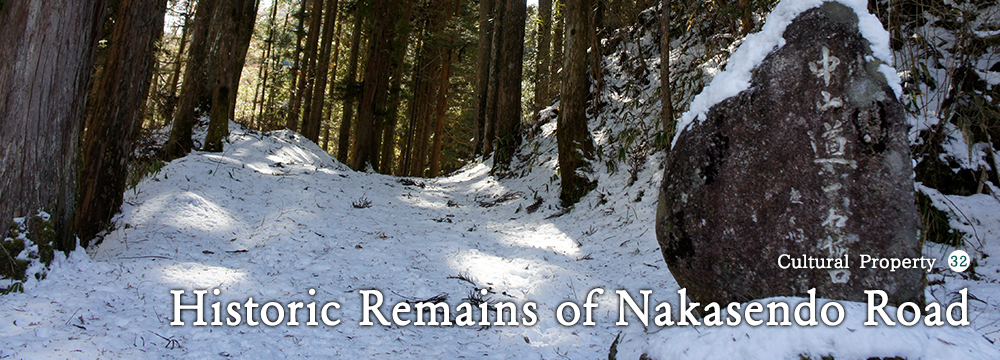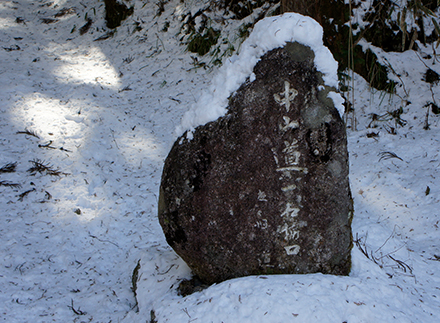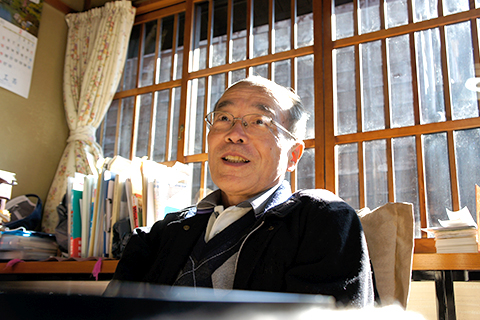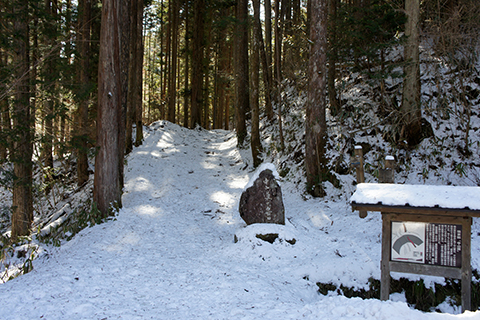

Story
In 1602, Ieyasu Tokugawa designated the Nakasendo Road as one of the five main highways and made some improvements to it. It connects Edo (Tokyo) and Kyoto. The 8.5 km part of the road within the entire 19.6 km between Magometouge Path and Nenouetouge Pass is a historic site, which keeps the former condition of Nakasendo.
Overview
A cobblestone road and milestones remain in the 4.5 km part of Nakasendo between Ochiai-juku, Mino and Magome-juku. The width of the road can be seen and the remains alongside the road are well preserved today. The small community on the pass provided accommodations, as it is located between the two post towns of Tsumago and Magome. A post townscape area and a country landscape area as large as 25 hectares are preserved, including houses and buildings of cattlemen (one character in Shimazaki’s novel “Before the Dawn” is a cattleman).
Points of Interest
It is about 8 km between Magoma and Tsumago, and takes 3 hours to walk slowly. There are many attractions on the way; a part of old Nakasendo in the original condition; Odaki and Medaki Falls, where Musashi Miyamoto (famous strong swordsman) is said to have made an ascetic practice; Ichikokutochi Bansho ruins.
Interview

Mr. Osami Hara, Tsumago-juku guide
We interviewed Mr. Osami Hara, who is a Tsumago-juku guide. He talked about Nakasendo, one of the five main highways in the Edo period.
“I started to work as a Nakasendo guide after retirement.
I have looked around Nakasendo and found all the 11 post towns remarkable. That’s why I chose to be a Nakasendo guide,” he said.
“I guide people for the area between Tsumago and Magome, starting from the tourist information center. It takes 30 - 60 minutes on foot. I have had over 40 tours and guided some 1,500 people.”
“Can you tell us what is remarkable about Nakasendo?”
“Most of all, the landscape is remarkable.
You can enjoy the landscape of olden times, as the road is not paved to preserve the condition of the time.
I love Nakasendo in fall. The fall foliage here is remarkable. I wish to enjoy it together with many people.”

Walking here in fall would be great
“Is there anything in the area that many people don’t know about?”
“Bato Kannon (horse-headed statue of Guanyin) is hidden in a place.” “Ask a guide to tell you where it is.
Participants often ask me about plants, trees, and flowers along the way, and I can answer every question. *laughs* Sometimes I have to do a search.
Baggage transport service is available (500 yen per piece). We would like to make walking tours comfortable for participants.”
“Do you have any ideas for the future?”
“We have many things in mind!
We are searching a new food specialty beside gohei-mochi (skewered rice cakes) and soba (buckwheat noodles).
“The number of family-run lodges has gone down. We must solve successor problems of such lodges and provide a fair number of accommodations for foreign tourists.”
As we heard him speak, we could sense how he cherishes Nakasendo.
Attractions
It is about 8 km between Magoma and Tsumago, and takes 3 hours to walk slowly. There are many attractions on the way; a part of old Nakasendo in the original condition; Odaki and Medaki Falls, where Musashi Miyamoto (famous strong swordsman) is said to have made an ascetic practice; Ichikokutochi Bansho ruins.
Access
From the closest station & interchange
From Nagiso Station on the JR Chuo Line
10 minutes by taxi
From the Ina Interchange or the Nakatsugawa Interchange on Chuo Expressway
National road 19 and 256, 30 minutes by car
Address
Tsumago Post Town Tourist Information Office
2159-2 Azuma, Nagiso Town, Kiso-gun, Nagano Prefecture
Phone:0264-57-3123